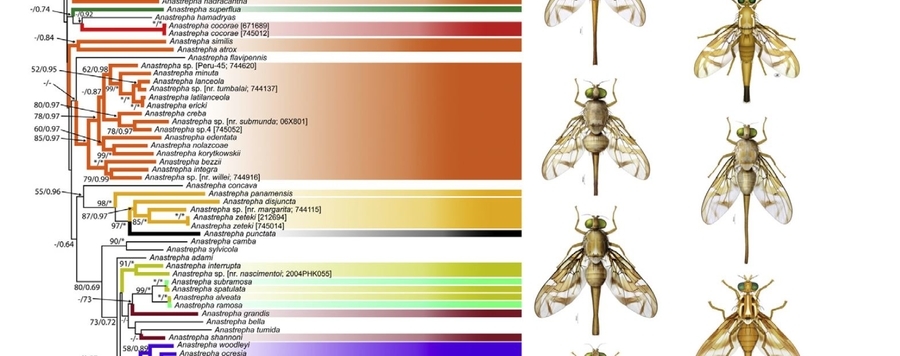
Phylogenetic relationships of Toxotrypanini
Current hypotheses of relationship among the species of the fruit fly genera Anastrepha and Toxotrypana are tested using sequence data from six DNA regions: the mitochondrial 16S rRNA gene; the 5’-region of the carbomoylphosphate synthase (CPS) domain of the rudimentary gene (CAD); the mitochondrial protein-coding gene cytochrome c oxidase subunit I (COI); the nuclear protein-coding gene elongation factor 1-alpha (EF1a); the nuclear protein-coding gene period (PER); and the nuclear protein-coding gene 6-phosphogluconate dehydrogenase (PGD). DNA sequences were obtained from 146 species of Anastrepha, representing 19 of the 21 species groups as well as five of the six clades of the robusta group, and four species of Toxotrypana in addition to species of Hexachaeta, Pseudophorellia, Alujamyia, and 13 other tephritid genera used as outgroups. The results indicate that Toxotrypana and Anastrepha should be considered synonyms. The group Anastrepha + Toxotrypana and the genus Toxotrypana are strongly supported as monophyletic, consistent with previous studies, but Toxotrypana arises within Anastrepha, confirming that Anastrepha as currently defined is paraphyletic. The placement of Toxotrypana within Anastrepha is clearly defined for the first time with high support, as the sister group to the cryptostrepha clade of the robusta group. The daciformis, dentata, leptozona, raveni, and striata groups are highly supported clades. The serpentina group is recognized with lower support, and the fraterculus and pseudoparallela groups are supported with minor alterations. The robusta group is resolved as polyphyletic, but four of the six species clades within it are recovered monophyletic (one clade is not represented and another is represented by one species). The punctata and panamensis groups are resolved together in a clade. At least some species of the mucronota group are related, however this group requires further study. The benjamini, grandis, and spatulata groups appear to be polyphyletic.






